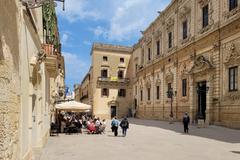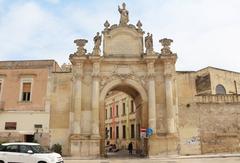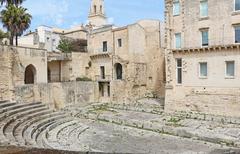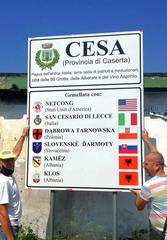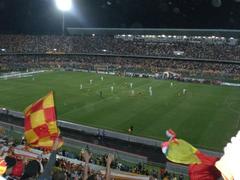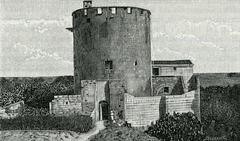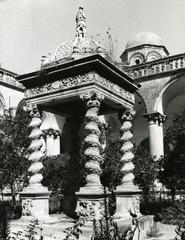Museo Archeologico Faggiano Visiting Hours, Tickets, and Guide to Lecce’s Historical Sites
Date: 14/06/2025
Introduction
The Museo Archeologico Faggiano is one of Lecce’s most intriguing hidden gems, offering a rare journey through more than 2,000 years of layered history beneath a single building. Discovered by chance in 2001 during routine plumbing repairs, this privately owned site has evolved into a celebrated archaeological museum. It presents a vivid, immersive narrative of Lecce’s past, featuring remnants from the Messapian civilization, Roman era, medieval times, and the modern period. Visitors can experience this extraordinary layering first-hand through preserved rock-cut tombs, ancient cisterns, ossuaries, cryptic tunnels, and thousands of artifacts.
This comprehensive guide details everything you need to plan your visit, including opening hours, ticket prices, accessibility, guided tours, and nearby attractions. It also explores the museum’s cultural impact and its vital role in preserving Lecce’s heritage and supporting sustainable tourism. For the most current information, consult the official Museo Archeologico Faggiano website, as well as additional trusted sources such as Leccenews24 and Archaeology News Network.
Table of Contents
- Introduction
- History and Origins
- Visitor Information
- Key Archaeological Features & Highlights
- Travel Tips & Nearby Attractions
- Frequently Asked Questions (FAQ)
- Cultural & Community Impact
- Visuals & Media Recommendations
- Conclusion
- References and Sources
History and Origins
Accidental Discovery and the Faggiano Family
In 2001, while attempting to resolve persistent humidity issues in his property at Via Ascanio Grandi, 56, Luciano Faggiano inadvertently uncovered a labyrinth of voids and chambers beneath his home (Museo Faggiano Official Site; Leccenews24). The Faggiano family transformed their private renovation project into a years-long archaeological excavation, revealing a palimpsest of civilizations that had occupied the site for millennia.
Archaeological Layers: Messapian to Modern Times
- Messapian Era (5th–3rd centuries BCE): Earliest tombs and burial sites, offering insight into pre-Roman funerary practices (Museionline).
- Roman Period: Discovery of cisterns, water channels, pottery, coins, and a segment of an ancient subterranean road (Leccenews24).
- Medieval and Religious Use: The building served as a Franciscan convent; remains include ossuaries, religious symbols, and hints of Templar connections (Museionline).
- Modern Era: The property returned to residential use before its accidental rediscovery and transformation into a museum (Museo Faggiano Official Site).
Visitor Information
Location and Directions
- Address: Via Ascanio Grandi, 56/58, 73100 Lecce, Italy
- Proximity: Steps from Porta San Biagio and within walking distance of Lecce’s train station and main historic sites.
- Access: Easily reached by foot, local bus (Via Trinchese stop), or car (public parking nearby).
Opening Hours
- Standard Hours: Daily, 09:30–20:00
- Last Admission: Generally 30–60 minutes before closing
- Note: Hours may vary on holidays—check official site for updates (aperturaorari.it).
Ticket Prices
- General Admission: €3–€8 (confirm current price on the official site)
- Reduced Admission: €5 (students, seniors, groups)
- Children under 12: Free
- Guided Tours: Available for an additional fee; advance booking recommended (whichmuseum.com).
Accessibility
- The museum’s subterranean layout involves stairs, narrow passageways, and uneven floors.
- Wheelchair access is limited, but staff can assist; contact in advance for specific needs (whichmuseum.com).
Guided and Self-Guided Tours
- Guided Tours: Led by the Faggiano family, offering personal anecdotes and detailed explanations.
- Self-Guided Visits: Informational panels (mainly in Italian); a translation app or booking a tour is suggested for non-Italian speakers.
Key Archaeological Features & Highlights
Visitors can experience a preserved cross-section of Lecce’s rich history, including:
- Messapian Road and Pavement: Ancient stone floors with circular holes for hut supports (visitlecce.eu).
- Roman and Medieval Cisterns: Water reservoirs, some still functional—and even used for musical performances due to their acoustics.
- Tombs and Ossuaries: Including a Roman infant grave and medieval communal ossuaries (Archaeology News Network).
- Religious Carvings and Templar Symbols: Mysterious markings linked to the Knights Templar (Historica Research).
- Artifacts: Over 5,000 items—ceramics, coins, glassware, and tools—spanning centuries.
Travel Tips & Nearby Attractions
- Footwear: Wear sturdy shoes for uneven surfaces and stairs.
- Best Times: Early morning or late afternoon for a quieter visit.
- Language: Guided tours or translation apps are recommended for non-Italian speakers.
- Nearby Sites: Basilica di Santa Croce, Roman Amphitheatre, Piazza del Duomo, and other key Lecce attractions are within easy walking distance (savoringitaly.com).
Frequently Asked Questions (FAQ)
What are the current visiting hours?
Open daily from 09:30 to 20:00 (aperturaorari.it).
How much are tickets?
Admission ranges from €3 to €8, with reductions for students, seniors, and children (whichmuseum.com).
Is the museum wheelchair accessible?
Some areas are challenging due to stairs and narrow corridors; contact the museum in advance for assistance.
Are guided tours available?
Yes—guided tours (often by the Faggiano family) are highly recommended and can be booked in advance.
Can I take photos?
Photography is permitted, but flash and tripods may be restricted.
Cultural & Community Impact
From Private Renovation to Community Heritage
Museo Faggiano’s transformation from a private home to a museum exemplifies the power of local initiative in heritage preservation (lecce.italiani.it). Supervised by professional archaeologists, the site is now a vital educational resource and a model for sustainable tourism.
Educational and Social Role
- Education: Welcomes school groups and university students; multidisciplinary exhibits encourage broad learning.
- Community Events: Hosts cultural and private events—concerts, exhibitions, and workshops.
- Economic Impact: Boosts local cultural tourism and supports neighboring businesses.
Supporting Local Identity
The museum connects personal stories with Lecce’s collective memory, fostering intergenerational dialogue and a sense of ownership among residents (lecce.italiani.it; whichmuseum.com).
Visuals & Media Recommendations
- Photography: Capture the unique underground chambers and stratified walls; use alt text like “Messapian tomb at Museo Faggiano.”
- Digital Resources: Explore virtual tours and interactive maps on the official website.
- Social Media: Follow for event updates and curated artifact highlights.
Conclusion
Museo Archeologico Faggiano is more than a museum—it’s a living testament to Lecce’s remarkable history, combining archaeological discovery with community engagement. Its accessible location, affordable admission, and immersive storytelling make it an essential destination for travelers and history enthusiasts alike. To maximize your experience, consider guided tours, special events, and exploring adjacent historical sites in Lecce’s enchanting old town.
For updated visiting hours, tickets, and events, always refer to the museum’s official website. Download the Audiala app for enhanced tours and translations, and follow us for the latest cultural news.
References and Sources
- Museo Faggiano Official Site
- Leccenews24 – Il Museo Archeologico Faggiano di Lecce
- Museionline – Museo Archeologico Faggiano
- Archaeology News Network – Subterranean World Beneath Italian Basement
- Historica Research – An Archaeological Museum
- The Tourist Checklist – Things to do in Lecce, Italy
- WhichMuseum – Best Museums in Lecce
- VisitLecce.eu – Museo Faggiano
- Atlas Obscura – Museo Faggiano
- Lecce.Italiani.it – Museo Archeologico Faggiano
- AperturaOrari.it – Museo Archeologico Faggiano Opening Hours
- SavoringItaly.com – Lecce Travel Guide
- Nomads Travel Guide – Museo Faggiano
